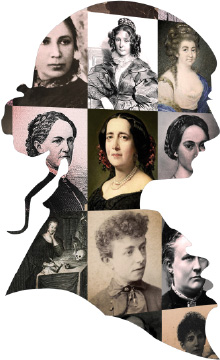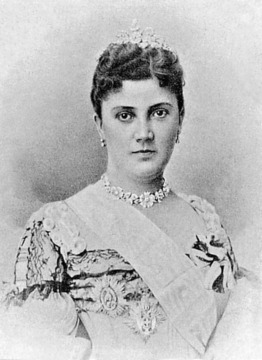Draga Mašin
1866–1903| Spouse | Svetozar Mašin, Aleksandar Obrenović |
|---|---|
| Other names | Rudničanka, Lunjevica |
| Date of birth | September 23, 1866 |
| Date of death | May 28, 1903 |
| Web address |
Personal situation
1866 - According to her birth certificate, Draga Mašin was born on September 23, 1866 (in the sources: September 11 or September 23, depending on whether the date is calculated according to the Gregorian or Julian calendar) in Gornji Milanovac, where she finished primary school, and then the Higher Institute for Women in Belgrade, better known as the "Cermanka's Institute". Her father's name was Panta Lunjevica, and her grandfather Nikola was the Duke in the Second Serbian Uprising and a friend of Miloš Obrenović. The Lunjevicas family, originally from Herzegovina, settled in the immediate vicinity of Ivanjica, and in the 18th century settled villages: Srezojevci, Beršići, Ljutovnica, Velereč, Velereč and Lunjevica on the slopes of the Rudnik Mountain. From the marriage with Andja Koljević, the daughter of the president of the municipality of Čačak at that time, Panta Lunjevica had six children, including Draga. The inaccuracies in the date of birth of Draga Mašin originate from the wariness of the contemporaries at that time towards the royal marriage, and the tendency to increase the age difference between Draga and her husband, king Aleksandar Obrenović, has been transferred to historiography. However, in 1886, Draga addressed the Funds Management Board to regulate the widow's pension by enclosing an excerpt with the exact dates of the birth of both spouses.
1883 - Left without a father, with her oldest sister Kristina, Draga took care of the brothers (Nikola and Nikodije), sisters Djurdjina and the youngest one Vojka (Ana). When Draga graduated from school, on August 28, 1883, she married Svetozar Mašin in the Belgrade Cathedral Church. The mining engineer by profession, Svetozar Mašin was the oldest son of Jovan Mašin, a Czech, the court physician of Prince Mihailo, and later of Prince Milan Obrenović. After the marriage, because of her husband's job, Draga lived in Karanovac, Krupanj, and Leskovac. In 1886, after three years of marriage, she returned to Belgrade. Svetozar Mašin suddenly passed away during an epileptic seizure. It is known that, as a widow, she had many financial problems. On June 12, 1961, Politika newspaper published an article entitled "The Found Letter of Draga Masin" addressed to the director of the commercial bank, typical of the period in which she lived, and attractively stylized, typical of the way of asking a loan at that time. In 1891, she began working at the Belgrade court as Queen Natalia's court lady. There are contradictory opinions about how Draga Mašin became the Queen's court lady. The youngest Draga's sister, Ana Lunjevica, recalled that in 1891 Draga received a call from the Queen to join her in Biarritz, France.
1891 - After joining Queen Natalija in 1891, she travelled with her to Moldova, Crimea, as well as to Biarritz in France, where her relationship with Aleksandar Obrenović began. In October 1897, Draga left Biarritz and resigned to the court lady's position for allegedly having been insulted by the queen. Allegedly, after Queen Natalija had suspected on the secret relationship of Draga Mašin and her son Aleksandar, she decided to move her away from herself. It is assumed that as a minor, Aleksandar began to sympathize with the ten years older Draga Mašin. As it turned out, the relationship of King Aleksandar and his mother's court lady was not a secret at all. In the correspondence of King Aleksander Obrenović and Draga Mašin until 1900, there was no mention of marriage.
1900 - They married on July 23, 1900, despite the opposition of many, especially Aleksandar's parents, Queen Natalija and King Milan Obrenović. By King Aleksandar's decree, Draga Mašin's birthday was proclaimed a national holiday, and she alone took care of decorating the court and taking care of finances, at the same time participating in the conduct of her husband's foreign policy. The people used to say "enjoying like Queen Draga", and the intolerance towards the royal couple grew strong. Numerous affairs shook the court: Draga's pseudo-pregnancy in 1901, the hypothesis of Draga as a "Russian agent" in the service of Russian interests in Serbia, the careless and arrogant behavior of Draga'a brothers who were believed to pretend to the throne.
1903 - Officers chose to plot against the King and the Queen. The assassination was carried out between 28th and 29th of May (some sources cite the dates of the Gregorian calendar on June 10 and 11) in 1903 and it is known as the May Coup. Captain Dragutin Dimitrijević-Apis, Aleksandar Mašin, Draga's former brother-in-law, and Djordje Genčić, former Draga's admirer, were one of the main organizers of the assassination.
| Place of birth | Gornji Milanovac |
|---|---|
| Place of death | Beograd |
| Nationality | Serbian |
| First language(s) | Serbian |
| Marital status | Remarried |
| Number of children | None |
| Social class | Aristocracy by marriage |
| Education | School education |
Professional situation
Before joining Queen Natalija, Draga Mašin showed a strong sense of language learning at Mrs. Cerman's Institute. She learned German, French, Christian science, natural sciences and the history of the Serbian people, and wrote small novels and articles for newspapers, also having been engaged in the translation of French and German authors. Before the age of eighteen, she translated from French a criminal novel of Xavier de Montépin, "Simone & Marie". Her teacher of French was Bogdan Popović, a future academic, anthologist, and aesthetician. That is why one part of the Serbian intellectual world loved and appreciated Draga. They considered her a very ambitious and influential lady in Belgrade. She was a patron of art. By her coming to the throne, great help was provided to Zmaj's Neven magazine.
She co-operated the longest in the magazine Domaćica (The Housewife), which was published within the Belgrade Women's Society under the patronage of the country, under the dynastic patronage and the influence of the wives of the most prominent politicians. In the work of the Women's Society, a branch that actively worked on networking and training of women in Serbia, Draga participated from 1886 to 1891 as a member of the editorial board, translating articles from foreign journals under the initials D.S.M. (Draga Svetozar Mašin) and publishing works under the pseudonym "Rudničanka" (The Woman from Rudnik). After marrying King Aleksander Obrenović, as a new queen, she took over the patronage in the Women's Society.
Sources:
Savremenici i poslednici Dositeja Obradovića i Vuka Stefanovića Karadžića sakupio, obradio i sredio Vlastoje D. Aleksijević (1911–1969); Šesta sveska: slovo M; Available on: http://digitalna.nb.rs/wb/NBS/Katalozi_i_bibliografije/P_425/P_425_06#page/0/mode/1up
Sekendek, Bogdan. "Lunjevice u srpskoj istoriji". U Priče o ljudima i događajima koji su menjali svet. Knj.3, Manje poznato, ali zanimljivo. Šabac: Zaslon, 2003, str. 198-220.
Stolić, Ana. Kraljica Draga Obrenović. Beograd: Zavod za udžbenike, 2009.
The author was edited by Milica Đuričić and Marija Bulatović
Translated by Marija Bulatović
| Profession(s) and other activities | translator and contributor to periodical press |
|---|---|
| Language(s) in which she wrote | Serbian |
| Financial aspects of her career | Stipend/allowance/pension |
| Memberships | Of editorial boards |
Works by this author
Translations
- Častan lopov 1300–2000
- Otadžbina 1883
- Policajka nazvana Mačije oko 1884, 1885
- Orgistkinja, ili trostruki zločin u Sentuenju 1888
- Ujak i sestrić 1888
- Tri miliona miraza 1896
Reception
Reception during lifetime
Reception after death
Authors read by this author
* Only authors in Knjiženstvo DB are shown



